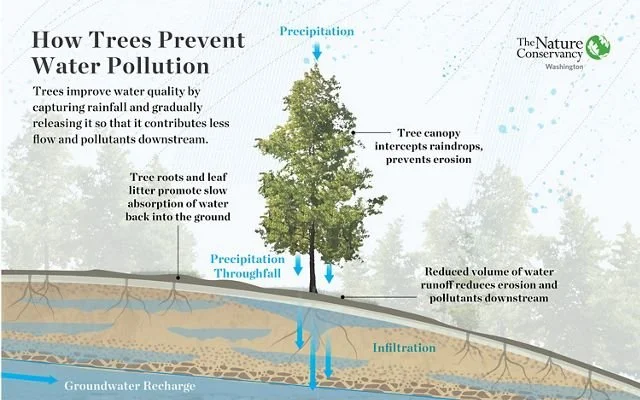Why Are Trees Important to the Ocean?
By Scarlett Bresnahan
Scarlett Bresnahan was an intern for WellKind Forestry during our fall 2022 session, exploring the ocean-forest connection and other environmental topics.
As Anton Chekhov once wrote, “Life on earth is inconceivable without trees.” His words ring just as true for oceans as it does for the land. It may not be obvious, but trees play a critical role in maintaining waterways and oceans.
One way trees support oceans is by diminishing ocean acidification. Ocean acidification is one of the largest threats to marine life. It makes it harder for animals to develop and survive. According to the National Oceanic and Atmospheric Association (n.d.), “Ocean acidification can create conditions that eat away at the minerals used by oysters, clams, lobsters, shrimp, coral reefs, and other marine life to build their shells and skeletons.”
By absorbing carbon dioxide, trees help prevent ocean acidification and protect marine life. The Nature Conservancy (n.d.) says that “Our global oceans absorb roughly a quarter of the CO2 released by human activities every year—resulting in a change to seawater chemistry known as ocean acidification.” Without the help of trees’ intake of carbon dioxide, the ocean would be far more polluted and much less diverse, given the only species to survive would be ones not affected by acidification. The coexistence of many marine animals depends on the support of trees.
Marine life also depends on proper water temperature. The oxygen trees gives off helps to regulate these temperatures. Trees cool water to increase dissolved oxygen levels (U.S. EPA, 2022). This makes it possible for aquatic animals to reproduce, supports growth, and sustains abundant populations.
Another benefit of trees is that they protect oceans against harmful runoff. Their roots keep out chemicals that cause pollution, one of them being chemical fertilizers. Greenhouse gasses cause acid rains, which can be devastating to oceans. An article by the National Scientific Foundation (2007) mentions, “This rain of chemicals changes the chemistry of seawater, with the increase in acidic compounds lowering the pH.” This is especially worrisome because many marine organisms are sensitive to low pH levels as well. In the article, Scott Doney goes on to explain that “The effects are most pronounced near the coasts, which are already some of the most heavily affected and vulnerable parts of the ocean due to pollution, overfishing and climate change.” Trees combat this problem by absorbing these harmful chemicals through their spores before they can wreak havoc on ocean ecosystems. Trees also reduce acid rain by acting as a much-needed natural filter for synthetic chemicals, including greenhouse gasses.
The positive effects of trees on the environment are undeniable. Their incredible ability to filter out harmful chemicals, regulate temperatures, and reduce ocean acidification has kept our oceans alive. Trees support marine organisms throughout their lives, making it possible for them to grow and reproduce. Without trees, the health of our water would be in jeopardy.
There has never been a more important time to conserve our forests.
References
Bender, M, Bustamante, R., & Leonard, K. (2022). Living in relationship with the ocean to transform governance in the UN Ocean decade. PLoS Biology, 20(10). https://journals.plos.org/plosbiology/article?id=10.1371/journal.pbio.3001828
Blomqvist, L., Brook, B. W., Ellis, E. C., Kareiva, P. M., Nordhaus, T., Shellenberger, M. (2013). Does the shoe fit? real versus imagined ecological footprints. PLoS Biology, 11(11). https://doi.org/10.1371/journal.pbio.1001700
Duffy, J. E., McCarroll, D., Loader, N. J., Young, G. H., Davies, D., Miles, D., Bronk Ramsey, C. (2019). Absence of age‐related trends in stable oxygen isotope ratios from Oak Tree Rings. Global Biogeochemical Cycles, 33(7), 841–848. https://doi.org/10.1029/2019gb006195
Ecosia. (2021, July 16). How trees reduce air pollution. The Ecosia Blog. Retrieved October 27, from https://blog.ecosia.org/how-trees-reduce-air-pollution-world-environment-day/
The National Oceanic and Atmospheric Administration. (n.d.). Understanding ocean acidification. NOAA Fisheries. https://www.fisheries.noaa.gov/insight/understanding-ocean-acidification#:~:text=For%20good%20reason%2C%20ocean%20acidification,health%20is%20also%20a%20concern.
The National Science Foundation. (2007, September 7). Acid rain has disproportionate impact on near-shore ocean waters [Press Release]. https://www.nsf.gov/news/news_summ.jsp?cntn_id=109997
The Nature Conservancy. (n.d.). How can trees help the seas? The Nature Conservancy. Retrieved October 27, 2022, https://www.google.com/search?q=The+Nature+Conservancy.+(n.d.).+How+can+trees+help+the+seas%3F&oq=The+Nature+Conservancy.+(n.d.).+How+can+trees+help+the+seas%3F&aqs=chrome..69i57j69i64.146j0j7&sourceid=chrome&ie=UTF-8
United States Environmental Protection Agency. (2022). Dissolved oxygen. U.S. EPA. United States Environmental Protection Agency. https://www.epa.gov/caddis-vol2/dissolved-oxygen


